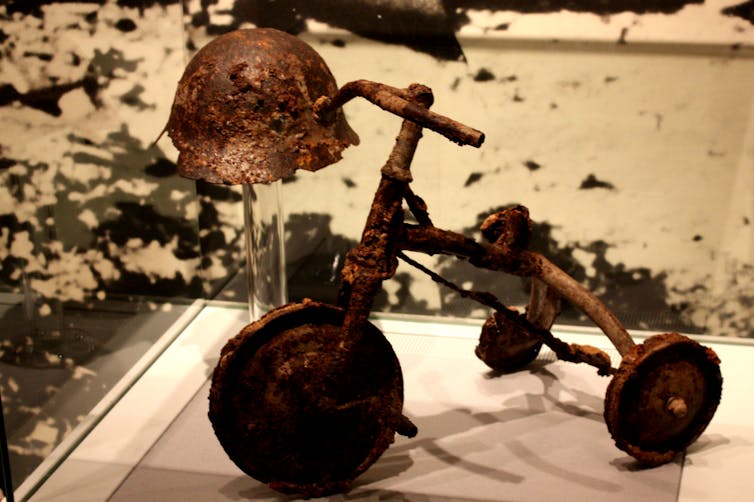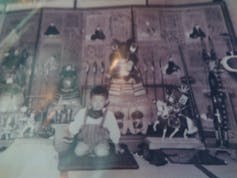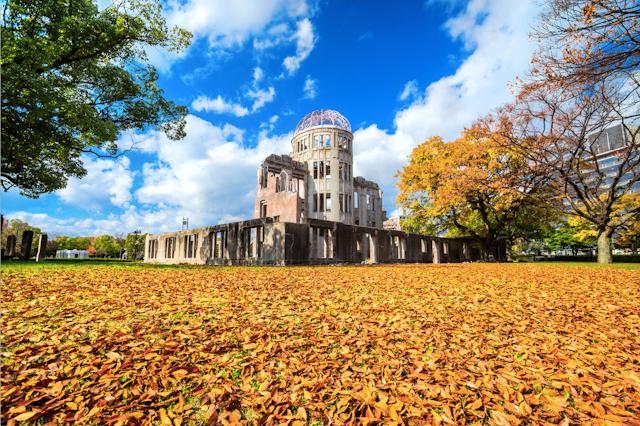The two atomic bombs dropped on Japan in August 1945 killed more than 200,000 people. The total population of Hiroshima at the time was about 350,000 and all would have experienced the effects of the atomic blast in various ways. In addition, an estimated 78,000 experienced radiation when they came into the city.
Of Hiroshima’s buildings, 92% were burned down – and Koreans, Russians, American POWs as well as Japanese were victims of the bombing. Many more died in subsequent decades due to the effects of radiation sickness.
The average age of survivors is now 80 years old. In five years’ time, it is likely that very few of these first-hand witnesses will be around to remember the event. And yet many of the stories of these people were, until recently, in danger of being lost forever due to the culture of silence that surrounds the survivors in Japan.
Their stories were stifled from the very beginning. Directly after the war in US-occupied Japan (1945-1952) even the word “atomic bomb”, genbaku in Japanese, was censored. And when the US left in 1952, the stories of the survivors were marginalised in the history of World War II as part of a post-war reconstruction which involved a deliberate collective amnesia.
Despite being ignored in the history books and ostracised culturally due to the cruel nature and genetic effects of atomic bomb sickness, those from Hiroshima and Nagasaki started to take action immediately after the bombing to preserve the memories of their city. They coined the English phrase No More Hiroshimas as early as 1946, and became their own cultural historians, raising funds internationally as well as locally to build memorials and museums.
Hiroshima’s Peace Park lies directly over the site of the dropping of the original atomic bomb. The Hiroshima Peace Memorial Museum aims to preserve the material damage and the stories of the survivors. Due to these efforts, Hiroshima is now one of the most visited cities in Japan. According to the most recent statistics available, 363,000 tourists visited Hiroshima City in 2012.

Survivors’ stigma
In Japan atomic bomb survivors are called hibakusha; hibaku meaning “sunbomb”, and sha “person”. They chose this term themselves in order not to use the Japanese term for survivor, out of respect for those who died. Despite the efforts of some in Hiroshima, many hibakusha still fear negative responses from society if they share their experience of the event.
The majority of the younger generation in Japan outside Hiroshima and Nagasaki have little awareness of the survivors, or indeed the atomic bombing of Hiroshima and Nagasaki, because of the way the subject is taught. Indeed, many young people say that the issue isn’t relevant to their lives and to their society.
There remains a social stigma attached to being a survivor. The norm is still for most to die in silence. Those who do speak out to journalists or researchers generally do so without their family members knowing. Frequently it is their grandchildren who encourage survivors to speak out – and it will be their descendants who will bear the responsibility for preserving and passing on the memories to the next generation.
Over the past three years I have been researching the narratives of the hibakusha of Hiroshima. I initially found that many survivors were wary of researchers. They often felt that their stories had been sensationalised; they were afraid of other people knowing they had been in the atomic bombing. One interpreter told me she had stopped working with foreign researchers.
But the situation is changing. As memory studies historians have pointed out, in the last few years there has been what Andreas Huyssen describes as a “memory boom”. The voices of the survivors have finally started to be heard and promoted.

Official bodies both in Japan and internationally – the Foreign Ministry of Japan and the UN Office of Disarmament Affairs – are starting to wake up to the needs of the memory boom. Local histories of Hiroshima and Nagasaki have become recognised to be a global concern as people around the world become more aware of the dangers of nuclear warfare. One Hiroshima survivor, Setsuko Thurlow, a Canadian émigré, has worked closely with Clifton Daniel Truman (the grandson of US president at the time of the bombings, Harry S Truman) to promote the stories of survivors worldwide.
More than words

But words sometimes don’t go far enough. So some survivors have released extraordinary creative projects in order to convey the complete destruction they experienced. One survivor I interviewed was Masaaki Tanabe, who has worked on the “ground zero restoration series”, a series of films which reconstruct the city of Hiroshima in computer graphics.
In the latest film, What Happened that Day (which premiered at the United Nations in New York in April), we are transported to the pre-war landscape of Hiroshima, seen through Tanabe’s childhood memories. With the aid of some CG imaging, we glide through a beautiful city, the Hiroshima of the 1930s, travelling along wide, leafy boulevards. We cross the newly constructed bridges spanning the seven tributaries of the Ota river. We pass under the nori curtains and into the interiors of the shops, only recently graced with electric light. We hear the tinkle of the bell announcing our arrival and survey the tofu, sweets and bicycles on sale. We are permitted entrance into the traditional so-called “eel-design” houses, which appear like those that still stand in Kyoto, and we find actors playing the roles of Tanabe’s own samurai family.

To make the film, Tanabe interviewed more than 300 survivors over a 17-year period so he could recreate an accurate 3D street landscape of the city. Accurate city records were all destroyed in the bombing. There were also very few citizens’ photographs that survived. Tanabe was only able to make the film because his mother had luckily evacuated 50 photo books put together before the bombing started in 1945.
It is only through such profound personal works that we can really start to understand the utter sense of cultural loss that people such as Tanabe experienced. The bomb killed everyone in his family except his grandmother on August 6 1945.
But more such efforts are sorely needed if we are to disperse the mushroom cloud that has obscured the central part survivors’ narratives play in this history.

